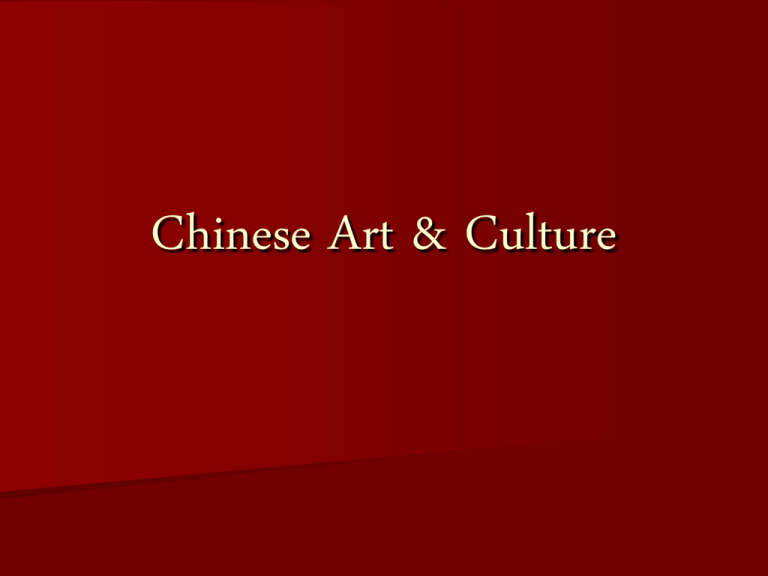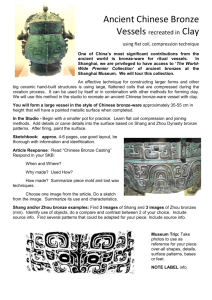Chinese Art & Culture
advertisement

Chinese Art & Culture Ancient Chinese Art Created between 1500 BCE when China began to be ruled by royal families called Dynasties and 1279CE when the Mongols conquered China (ie 3000 years of art) Chinese art developed differently in different parts of the country. Artists during this period are anonymous. Chinese Art & Religion Chinese art was inspired by Buddism, Daoism & the teachings of Confucious Buddhas & Bodhisattvas Sanxingdui 1200 BCE Most early art which has survived consists of Bronze pieces. This Bronze figure is almost 6 ‘ (1.8 m high) without a base, with the base it is over 9’ ( 2.7 m) high First early bronze which shows the human figure. Found in Central China Artwork Showing Trade Elephants lived in China during 1200BCE therefore ivory was also a local material. However, turquoise was a trade item. This beaker, ivory & inlaid with turquoise illustrates China’s trade . Evolution of Ceramics Ancestor Worship – Tomb Soldiers Patronage & Court Art Due to the high cost of materials, artists (including painters, weavers, bronze workers and carvers) looked for a patron first before they created a work of art Emperors set up workshops for weavers, bronze makers and carvers and regularly ordered paintings from preferred artists. From the Tang dynasty, a style of court art developed. Many of the nobles at court including the emperors themselves, were artists. Painting on silk scrolls & calligraphy became popular. Chinese Painting Calligraphy & Poetry Fan K’uan vs George Seurat Fan K’uan Principles of Chinese art Conventions of Space ie divided into 3 sections or planes eg in foreground is carefully rendered rock formation close to picture plane – separates and defines this plane. Middle ground is rocky hills & trees with roadway. Three waterfalls are woven into the geological structures. Travelers and pack animals located on road to right and a small pavilion or temple located among the trees. The background is composed of a backdrop of flattened, silhouetted mountains with defined outlines and brush-covered tops. The mountains are split by a deep cleft and on the right a thin cataract spills down the face of the rock. Foreground Rock seen from the side. Are we looking down from a birds’ eye view or is the rock at the same level as the road ie a boulder at our feet as we the viewer stand on a scene with this view. Middle ground – appears to be in profile as we see all of the trunk and upper limbs defined but the upper tree in the middle ground appears to be tilted backward. Mountain not shown as if we are looking up ie no diminution of size or foreshortening. If we accept the eye level of pines to the left of the temple, we are seeing too much of the trees and shrubs which cover the mountain peaks. Finally the tilting of the small plateaus at the top of the mountains towards the viewer demonstrate K’ai ho ( coherence) Georges Seurat Comparison West vs East How does Seurat’s work compare? Refer to his use … 1. Composition 2. Line 3. Colour






